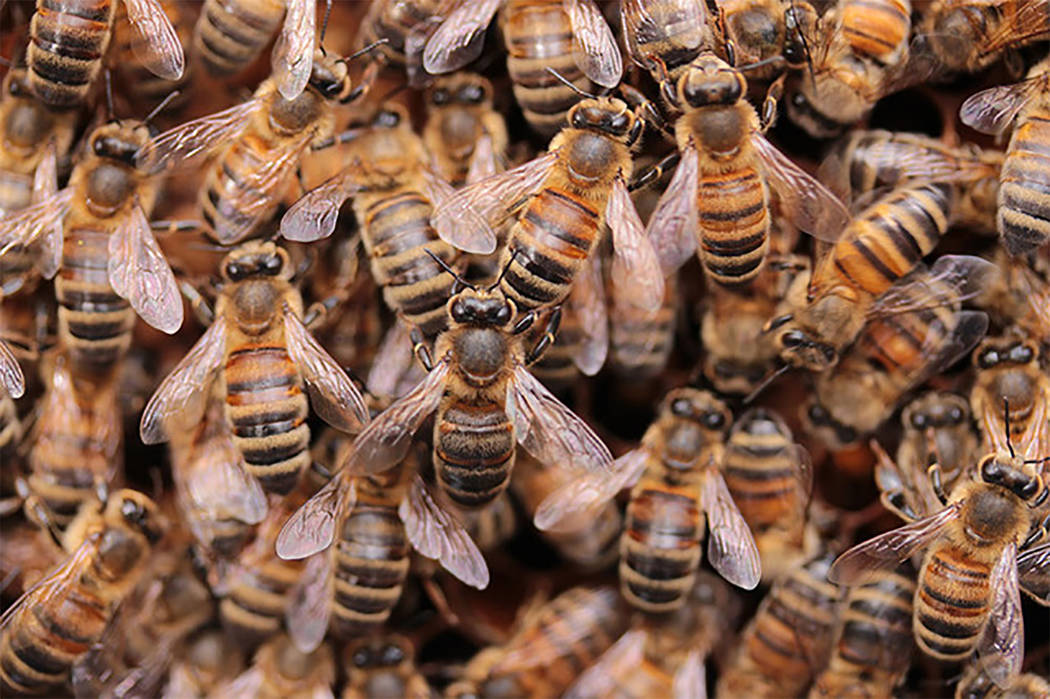
The recent warm springtime temperatures are causing swarms of bees to invade neighborhoods in the valley, according to local officials.
Pahrump Valley Fire and Rescue Chief Scott Lewis issued a news release on what to, and not to do when a beehive or swarm develops on a property.
The release declared if an immediate public safety emergency exists, including active attacks, or if bees are found in public spaces such as parks or schools, Pahrump Valley Fire and Rescue Services should be contacted immediately.
Conversely, the release suggested not call the Nye County Sheriff’s Office or Animal Control, as the agencies do not have the training, tools or general knowledge on handling bees.
“If citizens and business owners encounter beehives on their private property, they must call a licensed pest control company or professional beekeeper that does bee abatement,” the release stated. “Please call 911 only if the bee swarm presents an immediate danger. Otherwise, please call the Pahrump Valley Fire Department at 775-727-5658.”
The release also stated there’s a real possibility that a permanent nest of bees is located close to the swarm.
“The colony could be in a cavity in a tree, building, or some other object,” the release said. “This nest had a large population of honeybees and had run out of room to store honey, pollen and raise new bees. When this occurs, the bees will begin to raise new queens and shortly before the new queens hatch, the old queen will leave the hive with about one-half of the bees. The queen and bees will usually fly only a short distance. The queen will land on some object, and the bees will cluster around her, forming the swarm.”
While honeybees are not aggressive unless protecting their colony, the Africanized variety have been spotted in parts of Southern Nevada.
Additionally, the U.S. Department of Agriculture provided suggestions on what to do if under attack by a bee swarm:
■ Run away quickly and do not stop to help others, unless small children, the elderly or disabled are also in harm’s way.
■ As you are running, pull your shirt up over your head to protect your face, but make sure it does not slow your progress as this will help keep the bees from targeting the sensitive areas around your head and eyes.
■ Do not stop running until you reach shelter, such as a vehicle or building. A few bees may follow you indoors, but if you run to a well-lit area, the bees will tend to become confused and fly into windows.
■ It’s also important to remember not to jump into water, as the bees will actually wait for you to come up for air. If you are trapped for some reason, cover up with blankets, sleeping bags, clothes or whatever else is immediately available.
■ The USDA also warns not to swat at the bees or flail your arms, as bees are attracted to movement, and crushed bees emit a smell that will attract more bees.
■ Once you have reached shelter or have outrun the bees, remove all stingers.
■ When a honeybee stings, it leaves its stinger in the skin, which kills the honeybee so it can’t sting again, but it also means that venom continues to enter the wound for a short time.
■ Do not pull stingers out with tweezers or your fingers, as the action will squeeze more venom into the wound. Instead, scrape the stinger out sideways using your fingernail, the edge of a credit card, a dull knife blade or other straight-edged objects.
■ If you see someone being attacked by bees, encourage that person to run away or seek shelter.
■ Do not attempt to rescue the person yourself. Instead, call 911 to report a serious stinging attack. The emergency response personnel in your area have probably been trained to handle bee attacks.
■ If you have been stung more than 15 times or are feeling ill, or if you have any reason to believe you may be allergic to bee stings, seek medical attention immediately.
■ The average person can safely tolerate 10 stings per pound of body weight, meaning that although 500 stings can kill a child, the average adult could withstand more than 1,100 stings.
Earlier this month, fire crews were summoned to a residence on the 2500 block of Zephyr Street to investigate a bee swarm on the porch of the home.
“Crews found that most likely, that swarm was going to be temporary or a transient swarm moving from one location to another,” Lewis said. “It’s my understanding that the swarm later dispersed. This was merely an investigation on our part to make sure there was a safe area for the occupant, who was an elderly female.”
Contact reporter Selwyn Harris at sharris@pvtimes.com, on Twitter: @pvtimes